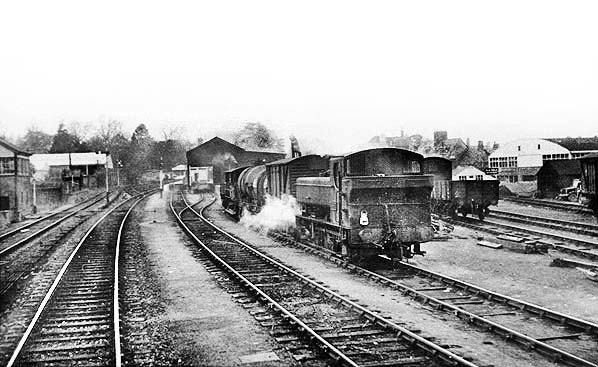 This view of shunting in the goods yard is hard to date but is probably c1960. The yard continues to be busy. To centre left of the photograph is the replacement goods shed, which clearly has only one internal track.
This view of shunting in the goods yard is hard to date but is probably c1960. The yard continues to be busy. To centre left of the photograph is the replacement goods shed, which clearly has only one internal track.
Photo from Adrian Vaughan
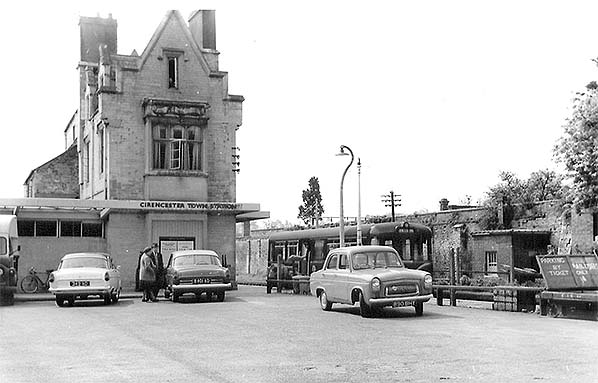 Looking south at Cirencester Town station in 1961, with some of the alterations which commenced in 1956 being visible. The building is somewhat grubby with the old and new sitting rather uncomfortably together but at the same time offering a hint of, for the time, modernity. Motor cars present are a pair of Mk II Ford Consuls and, to the right, a Ford Prefect 100E. The British Railways van just visible at far left cannot be identified beyond doubt but was probably a Commer 1½ ton FC. At the far right a rather crude notice, mounted upon a platform barrow, informs motorists that car parking is for rail users only and a fee is payable, illustrating that this is by no means a more recent thing. An AC Cars diesel railbus waits at the platform while what appear to be parcels are unloaded, perhaps to be delivered by the van at the far left. These railbuses contained two luggage pens, behind each door pocket and diagonally opposite each other, but it nevertheless highlights the problem with these small vehicles when compared to a conventional train with commodious van.
Looking south at Cirencester Town station in 1961, with some of the alterations which commenced in 1956 being visible. The building is somewhat grubby with the old and new sitting rather uncomfortably together but at the same time offering a hint of, for the time, modernity. Motor cars present are a pair of Mk II Ford Consuls and, to the right, a Ford Prefect 100E. The British Railways van just visible at far left cannot be identified beyond doubt but was probably a Commer 1½ ton FC. At the far right a rather crude notice, mounted upon a platform barrow, informs motorists that car parking is for rail users only and a fee is payable, illustrating that this is by no means a more recent thing. An AC Cars diesel railbus waits at the platform while what appear to be parcels are unloaded, perhaps to be delivered by the van at the far left. These railbuses contained two luggage pens, behind each door pocket and diagonally opposite each other, but it nevertheless highlights the problem with these small vehicles when compared to a conventional train with commodious van.
Photo
by RK Blencowe
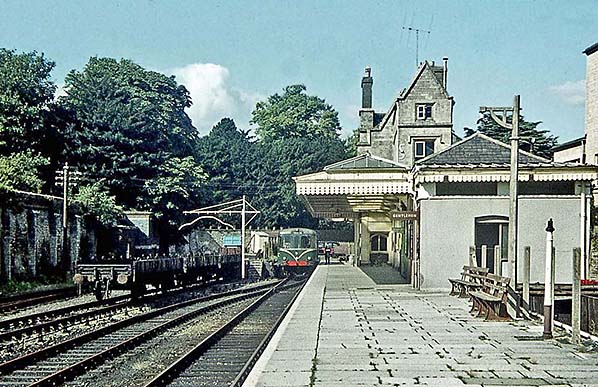 One of two views captured on an apparently quiet Monday 17 July 1961. An AC Cars diesel railbus awaits custom at Cirencester Town. Evidence of the 1956 alterations to the station is visible; this work continued into 1957 before being abruptly halted. Two GWR benches stand on the platform in an untidy manner, overseen by a new concrete lamp post adjacent to a redundant gas lamp stanchion. The open air section of platform is becoming rather weedy due to lack of use since the introduction of railbuses. Beyond the 'Gentlemen' sign can just be made out a sign announcing 'Tickets'. It indicates the position of the 1956 ticket office and the sign appears to have been a simple, locally made item. The wagons on the left are on the end-loading dock road. Wagons of this type could been seen at Cirencester carrying agricultural machinery, tethered by means of the eyes along the wagon sides. The tall, slender station building is seen to good effect in this view. It is said this came about due to the station originally having a trainshed (overall roof).
One of two views captured on an apparently quiet Monday 17 July 1961. An AC Cars diesel railbus awaits custom at Cirencester Town. Evidence of the 1956 alterations to the station is visible; this work continued into 1957 before being abruptly halted. Two GWR benches stand on the platform in an untidy manner, overseen by a new concrete lamp post adjacent to a redundant gas lamp stanchion. The open air section of platform is becoming rather weedy due to lack of use since the introduction of railbuses. Beyond the 'Gentlemen' sign can just be made out a sign announcing 'Tickets'. It indicates the position of the 1956 ticket office and the sign appears to have been a simple, locally made item. The wagons on the left are on the end-loading dock road. Wagons of this type could been seen at Cirencester carrying agricultural machinery, tethered by means of the eyes along the wagon sides. The tall, slender station building is seen to good effect in this view. It is said this came about due to the station originally having a trainshed (overall roof).
Photo
by Reg Viney from his Flickr photostream
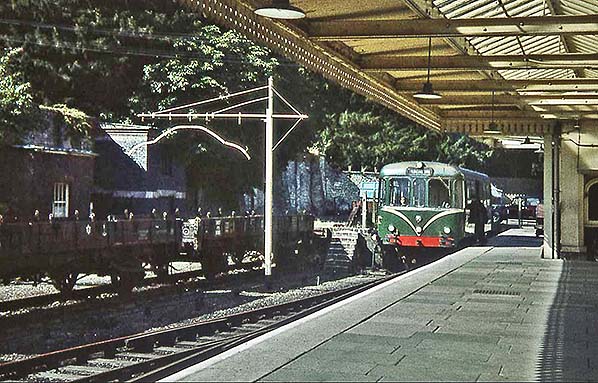 The second of two views taken on Monday 17 July 1961. The station highlights well the diminutive size of these 46-seat diesel railbuses. Following testing and driver training, much of the latter being undertaken on the Tetbury branch, railbuses took over the Cirencester and Tetbury branches on and from Monday 2 February 1959. The last scheduled steam passenger train on the Cirencester branch having run the previous day, although steam was still to appear on goods workings and enthusiast specials. AC Cars Ltd. supplied five railbuses to BR, Nos. W79975 - 8 and SC79979. On the first day of public operation No. W79976 was at work on the Cirencester branch with No. W79978 doing the honours on the Tetbury branch. The original Diagrams would have seen the pair change over at some point during the day. The wagons on the left are seen in another view captured on the same day. Used for carrying machinery, typically agricultural, the wagon furthest from the camera nevertheless appears to be marked as being allocated to Permanent Way duties. The loading gauge, one of two identical examples at Cirencester, is of the type with hinged outer ends on its gauge bar. Operated by wires and pulleys, the purpose of this type was to gauge loads which were either staying within Great Western territory or moving onto other companies’, or BR Regions’, lines. The Great Western loading gauge was slightly more generous, being a legacy of the broad gauge. Hiding among the shadows on the left are two brick huts, one of which is two-storey. One hut was originally a porters room and the other an oil store, although the reason for one being two-storey is unclear. The huts would have been a legacy of the station's original overall roof form, as was the supporting wall behind them.
The second of two views taken on Monday 17 July 1961. The station highlights well the diminutive size of these 46-seat diesel railbuses. Following testing and driver training, much of the latter being undertaken on the Tetbury branch, railbuses took over the Cirencester and Tetbury branches on and from Monday 2 February 1959. The last scheduled steam passenger train on the Cirencester branch having run the previous day, although steam was still to appear on goods workings and enthusiast specials. AC Cars Ltd. supplied five railbuses to BR, Nos. W79975 - 8 and SC79979. On the first day of public operation No. W79976 was at work on the Cirencester branch with No. W79978 doing the honours on the Tetbury branch. The original Diagrams would have seen the pair change over at some point during the day. The wagons on the left are seen in another view captured on the same day. Used for carrying machinery, typically agricultural, the wagon furthest from the camera nevertheless appears to be marked as being allocated to Permanent Way duties. The loading gauge, one of two identical examples at Cirencester, is of the type with hinged outer ends on its gauge bar. Operated by wires and pulleys, the purpose of this type was to gauge loads which were either staying within Great Western territory or moving onto other companies’, or BR Regions’, lines. The Great Western loading gauge was slightly more generous, being a legacy of the broad gauge. Hiding among the shadows on the left are two brick huts, one of which is two-storey. One hut was originally a porters room and the other an oil store, although the reason for one being two-storey is unclear. The huts would have been a legacy of the station's original overall roof form, as was the supporting wall behind them.
Photo
by Reg Viney from his Flickr photostream
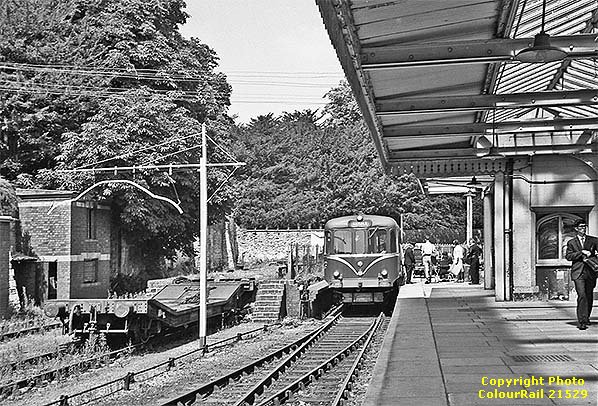 AC Cars Railbus at Cirencester Town on 27 July 1963, stopped close to buffers as usual and apparently collecting some passengers. The tracks to the left lead to the end loading dock. Although weeds are starting to grow, the nearest track has a well-wagon on it, suggesting that it is still in use.
AC Cars Railbus at Cirencester Town on 27 July 1963, stopped close to buffers as usual and apparently collecting some passengers. The tracks to the left lead to the end loading dock. Although weeds are starting to grow, the nearest track has a well-wagon on it, suggesting that it is still in use.
Copyright photo ColourRail
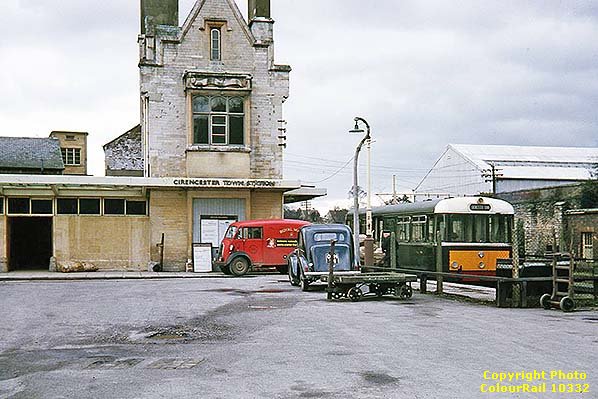 AC Cars Railbus W79977 at Cirencester Town on 25 March 64. Stopping the railbus close to the buffers made it easy for the postman to transfer mail between his van and the railbus. Passenger access on to the platform was now where the post van is parked.
AC Cars Railbus W79977 at Cirencester Town on 25 March 64. Stopping the railbus close to the buffers made it easy for the postman to transfer mail between his van and the railbus. Passenger access on to the platform was now where the post van is parked.
Copyright photo ColourRail
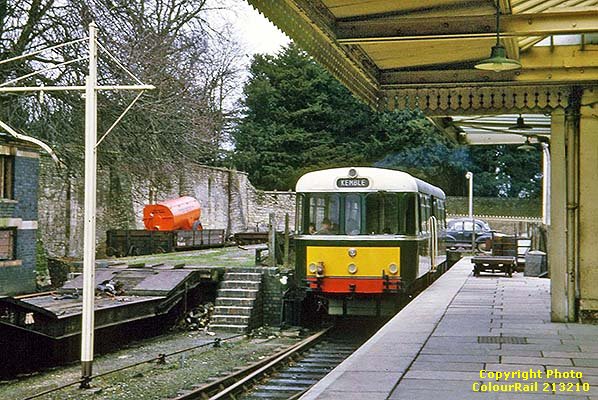 AC Cars railbus, W79977, stopped near the buffers on 25 March 1964. The items on the platform are presumably about to be loaded on to it. Two of the end-loading docks are in use,The orange cylindrical trailer is a Howard Rotaspreader, this was the latest innovation in farm manure spreaders at that time. Introduced in the early 1960's, variations of this type of spreader are still produced today. Using a rotating longitudinal chain flail on the centreline of the cylinder the muck was thrown out from the open far side of the spreader.
AC Cars railbus, W79977, stopped near the buffers on 25 March 1964. The items on the platform are presumably about to be loaded on to it. Two of the end-loading docks are in use,The orange cylindrical trailer is a Howard Rotaspreader, this was the latest innovation in farm manure spreaders at that time. Introduced in the early 1960's, variations of this type of spreader are still produced today. Using a rotating longitudinal chain flail on the centreline of the cylinder the muck was thrown out from the open far side of the spreader.
Copyright photo ColourRail
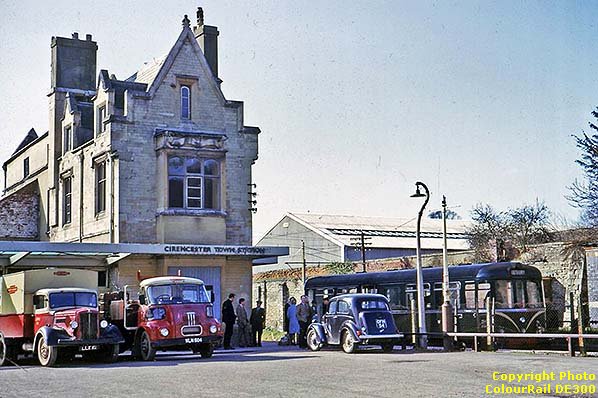 A railbus at Cirencester Town station on 26 Mar 1964. Two railway vehicles are in the forecourt, probably loading or unloading via the rebuilt single-storey building. The original three-storey building is in good condition, although the ground floor bay window has been blocked.
A railbus at Cirencester Town station on 26 Mar 1964. Two railway vehicles are in the forecourt, probably loading or unloading via the rebuilt single-storey building. The original three-storey building is in good condition, although the ground floor bay window has been blocked.
Copyright photo ColourRail
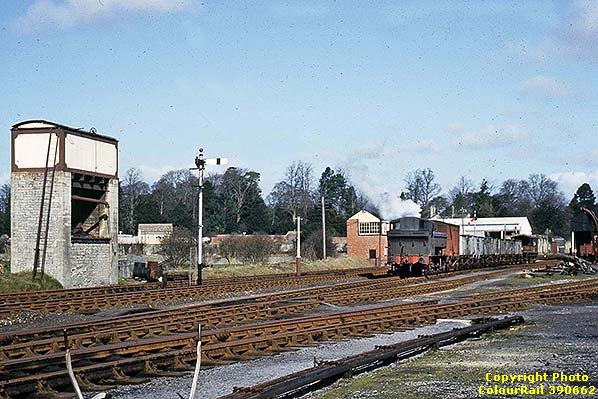 A pannier tank 1664 shunts in the goods yard on 26 March 1964. The unusual design of water tower can be seen to the left of the photo, and the GWR Type 5 signal box can be seen behind the loco.
A pannier tank 1664 shunts in the goods yard on 26 March 1964. The unusual design of water tower can be seen to the left of the photo, and the GWR Type 5 signal box can be seen behind the loco.
Copyright photo ColourRail
old36.jpg) On Sunday 5 April 1964 BR black liveried ex-GWR 0-4-2T No. 1472 poses for the camera. The occasion was the Gloucestershire Railway Society railtour with the to-the-point but rather clumsy title "Cirencester Town and Tetbury Branches Last Steam Train". The train ran from Gloucester Central to Kemble then covered the two branches, Tetbury first, before returning to Gloucester Central. This was the final day of passenger services over the Cirencester branch; regular services on the Tetbury branch having ceased the previous day as, unlike the Cirencester branch, it did not have a Sunday service. The train is formed of two auto-trailers (Push-Pull driving trailers) built to the design of F.W. Hawksworth. The number of the locomotive was well recorded, despite it being obvious from numerous photographs, yet it would appear nobody bothered to record the numbers of the auto-trailers. However, somebody rather carelessly allowed the number of that coupled behind the locomotive to be clearly visible in one photograph. It is No. W223W, one of a batch built by British Railways in 1951 and it is likely the second vehicle was from the same batch. This is the only recorded occasion when either that type of loco or carriages were used on the Cirencester Town branch, but it would have eased all the reversals needed at Kemble. These vehicles were fitted with retractable steps for use at lineside halts and the handrails for these are visible in the photograph. On the left, what appears to be a Combine Harvester awaits, presumably, unloading onto the goods dock. Agricultural machinery by rail was a frequent sight at Cirencester Town. Locomotive No. 1472 was new ex Swindon Works in April 1936 as No. 4872, being renumbered to 1472 in October 1946. A few class members have survived into preservation but No. 1472 is not among them, being withdrawn in November 1964 and subsequently scrapped at J. Cashmore, Newport, in February 1965.
On Sunday 5 April 1964 BR black liveried ex-GWR 0-4-2T No. 1472 poses for the camera. The occasion was the Gloucestershire Railway Society railtour with the to-the-point but rather clumsy title "Cirencester Town and Tetbury Branches Last Steam Train". The train ran from Gloucester Central to Kemble then covered the two branches, Tetbury first, before returning to Gloucester Central. This was the final day of passenger services over the Cirencester branch; regular services on the Tetbury branch having ceased the previous day as, unlike the Cirencester branch, it did not have a Sunday service. The train is formed of two auto-trailers (Push-Pull driving trailers) built to the design of F.W. Hawksworth. The number of the locomotive was well recorded, despite it being obvious from numerous photographs, yet it would appear nobody bothered to record the numbers of the auto-trailers. However, somebody rather carelessly allowed the number of that coupled behind the locomotive to be clearly visible in one photograph. It is No. W223W, one of a batch built by British Railways in 1951 and it is likely the second vehicle was from the same batch. This is the only recorded occasion when either that type of loco or carriages were used on the Cirencester Town branch, but it would have eased all the reversals needed at Kemble. These vehicles were fitted with retractable steps for use at lineside halts and the handrails for these are visible in the photograph. On the left, what appears to be a Combine Harvester awaits, presumably, unloading onto the goods dock. Agricultural machinery by rail was a frequent sight at Cirencester Town. Locomotive No. 1472 was new ex Swindon Works in April 1936 as No. 4872, being renumbered to 1472 in October 1946. A few class members have survived into preservation but No. 1472 is not among them, being withdrawn in November 1964 and subsequently scrapped at J. Cashmore, Newport, in February 1965.
Copyright photo ColourRail
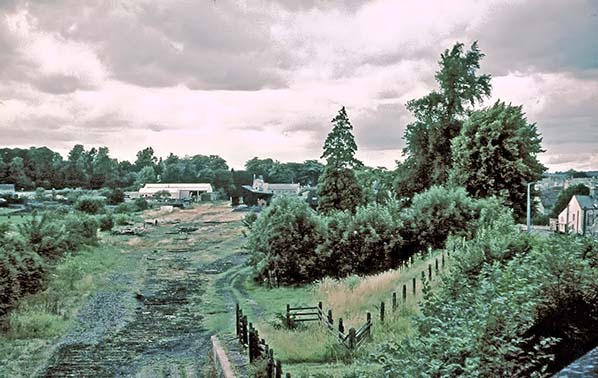 View c 1970 probably from the Querns Lane bridge, showing the situation after closure and track lifting but before building of Hammonds Way and the new bypass. The former pig dock can be seen bottom centre and the goods shed and station building can be seen in the distance.
View c 1970 probably from the Querns Lane bridge, showing the situation after closure and track lifting but before building of Hammonds Way and the new bypass. The former pig dock can be seen bottom centre and the goods shed and station building can be seen in the distance.
Photo
from Steve Bartlett collection
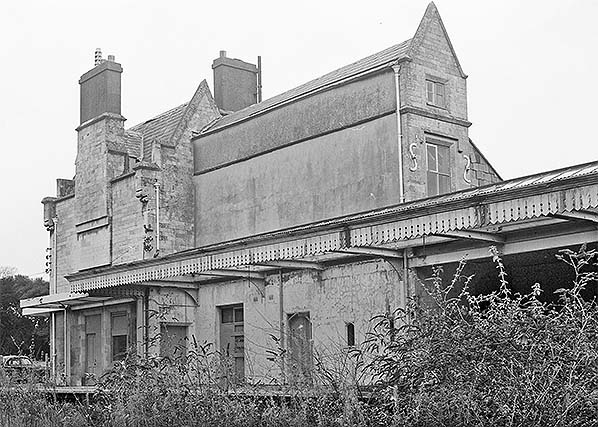 One of a series of photos taken c1973 showing the station after closure but before the platform canopy and platform were removed.
One of a series of photos taken c1973 showing the station after closure but before the platform canopy and platform were removed.
Photo
from John Mann collection
Click here for Cirencester Town Gallery 5:
c1973 - 1973

